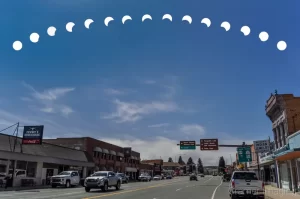
Lately, the US was blessed to enjoy 2 different solar eclipses, one an annular eclipse (or ring of fire) and the other a total eclipse. When I first learned of these eclipses, I started making some plans. You can learn how the ring of fire eclipse this past October (at time of writing) when for me by reading this article. But I’m not here to rehash that story. I’m here to tell you about my experience with the second eclipse. How did that total solar eclipse go for me? Here’s the cliff notes version: I only experienced a partial solar eclipse instead.
We couldn’t make the trek to the line of totality. It didn’t matter how much I wanted to (and I did want to), it just wouldn’t work. So, instead, I contented myself with the idea of practicing more solar eclipse photography by shooting the partial solar eclipse which was visible where I live. I thought about where to shoot from. However, in the end, I elected to shoot right in the middle of town. The entire partial eclipse was visible from start to finish overhead. The clouds did worry me for a bit. But, as you can see, I found nothing but clear blue skies for the sun’s path.
Being early April, the winds were horrible. They were strong and cold. I needed to stabilize my tripod so I could shoot. Otherwise, the photos turned out blurry. Thankfully, I had several options to-hand which would work as ballast. With that settled, I bundled up for the 2 hour sky show and waited. Also, I dusted off my eclipse glasses from October to track the progress of the partial eclipse.

The eclipse began as all solar eclipses do. First, there was no visible progress at all. Then there was a missing crumb which grew into a nibble which grew into a bite. Finally, at the peak of the partial solar eclipse, there was a significant bite out of the sun. Then things receded just as fast or slowly as they began. The bite diminished down to a nibble, then to a crumb, then finally vanished as the moon and sun moved apart. Also, I periodically made a point of shooting some foreground just in case I wanted to use it later.
As I watched and waited, a few people went about their lunchtime business on the streets. Cars drove by. A handful of people took interest in what I was doing on the sidewalk. For those who asked in reasonable time, I let them borrow my eclipse glasses to see for it themselves. In that way, not less than 4 kind gentlemen enjoyed a brief glance at the show in the sky. One of them was a UPS driver who was ecstatic that he managed to pull into a spot and simultaneously not block my sky view. The rest where locals.

Strangely enough, more people took notice of the eclipse in progress and asked me about it after the 53% peak of the partial eclipse was over. I don’t know why that was, just that that’s how it happened. One lady seemed very disappointed to learn that the eclipse had a mere 5 minutes to go before it ended when she asked me if I was waiting for it.
In the end, the partial solar eclipse was nowhere near the sky show that the total eclipse was. I experienced the totality of 2017’s eclipse, so I know. Still, it was worth doing something with. The eclipse photography practice was invaluable. Also, I got another good use out of those eclipse glasses acquired last year.
So, now I turn things over to you. What do you think of my take on the partial solar eclipse? Was it worth the chill and the wind to capture? Please leave your thoughts in the comments section below.
Join our email-only photo of the week club to get the full stories behind how we captured our favorite fine art landscape photos.
We respect your privacy.


Receive monthly updates in your inbox from us.

Join our email-only photo of the week club to get the full stories behind how we captured our favorite fine art landscape photos.
We respect your privacy
No More Results